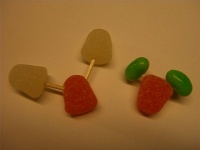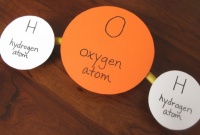AY Honors/Water Science/Answer Key
1. Making use of household products build a 3-D model of the water atom. Explain its chemical composition.
The water molecule is formed when two Hydrogen (H) are united via a covalent bond to one Oxygen atom (O); H2O. There are many ways to create models. The photos below provide some ideas.
2. List and describe (in writing or orally) some characteristics of water that distinguish it from nearly all elements?
Water is odorless, tasteless and colorless. Water has a remarkable ability to resists rapid changes in temperature. As a result, water-cools and warms up more slowly than air. This serves as a clear advantage for marine life that requires a more stable body temperature, creating a more desirable environment in which to live.
Another remarkable ability of water is that it expands when it freezes. This characteristic of water gives it the ability to sustain marine life during the winter seasons, after the water has frozen on top. The expansion of water also causes crystals to form. This gives water the ability to kill cells since the crystals can break cells apart. Freezing water can also causes rocks to break after the water expands from inside.
3. Making use of photos, diagrams, or any other form of visual aid illustrate the three states of water.
4. Describe, illustrate or represent the difference between clouds, snow and rain.
Clouds, snow, and rain are all made up of some form of water. A cloud is made of tiny water droplets and/or ice crystals, a snowflake is an aggregate of many ice crystals, and rain is just liquid water.
5. Through photos or diagrams identify and list the five main types of precipitation.
The main types of precipitation are:
- Rain
- Snow
- Sleet
- Freezing rain
- Hail
6. What is the boiling and freezing point of water?
The boiling point of water is 212 °F or 99.98 °C. The freezing point of water is 32 °F or 0.0 °C.
7. Water Trivia: The following questions can be utilized in different forms to promote learning and understanding about water. Questions can be adapted for Jeopardy, Bingo, and Wheel of Fortune among many others. Creativity is strongly encouraged.
- a. What is the estimated weight of one gallon/4 liters of water?
- b. The human body consists of how much water?
- c. What is the largest ocean on Earth?
- d. What is the largest lake in the World?
- e. What is the largest lake in North America?
- f. Can sound travel faster through water or air?
- g. What is the deepest point in the world’s oceans?
- h. What is the longest river on Earth?
- i. How long can a person survive without water?
- j. What makes water hard?
- k. What uses the most water in households?
- l. What is the word used to describe how much water vapor is in the air?
- m. What is the name of the canal that connects the Pacific Ocean with the Atlantic Ocean?
- n. Which conducts heat more efficiently – water or air?
- o. How much water do you need to drink daily?
- p. What chemical is added to water to kill harmful germs?
- q. How many gallons/liters of water are used in a 5-minute shower?
- r. What is the longest navigable river in your country?
- s. T or F: Water is often called the universal solvent because many things can be dissolved in it.
8. Answer the following:
- a. How much of the earth is covered by water?
- b. How much of the earth’s water is fresh water?
- c. Where is water found on earth?
9. Select three of the following and discuss at least one way water is used.
- a. Agriculture
- b. Washing
- c. Drinking
- d. Fire Extinction
- e. Transportation
10. What is a body of water? Through photos, diagrams or sketches, be able to illustrate the following bodies of water below, naming one that can be found in your city, town, county or state. (if possible)
- a. River
- b. Lake
- c. Sea
- d. Ocean
- e. Rapid
- f. Canal
- g. Creek
- h. Basin
- i. Glacier
- j. Gulf
- k. Harbor
- l. Lagoon
- m. Reservoir


